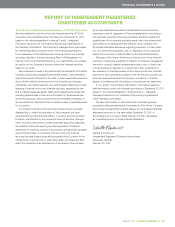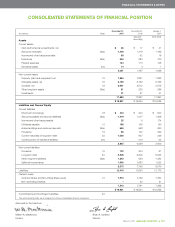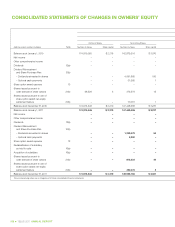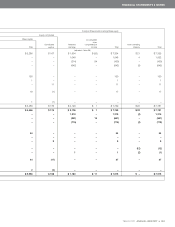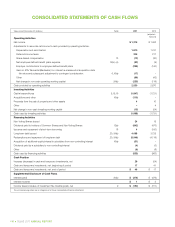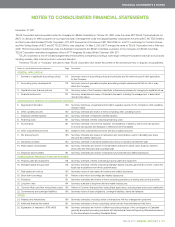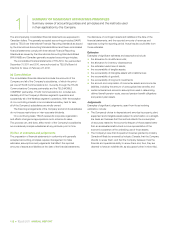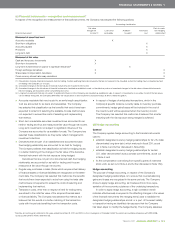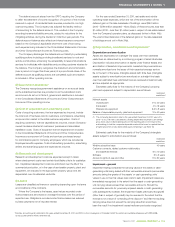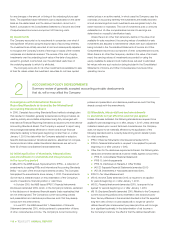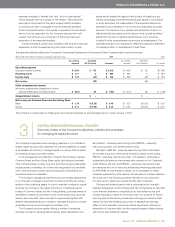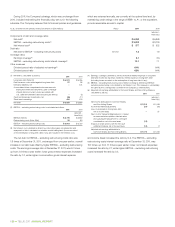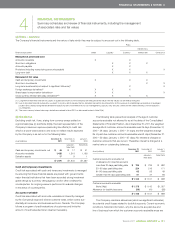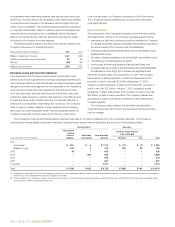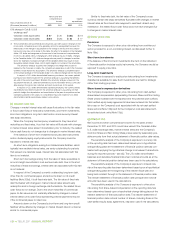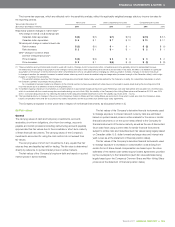Telus 2011 Annual Report Download - page 119
Download and view the complete annual report
Please find page 119 of the 2011 Telus annual report below. You can navigate through the pages in the report by either clicking on the pages listed below, or by using the keyword search tool below to find specific information within the annual report.
TELUS 2011 ANNUAL REPORT . 115
FINANCIAL STATEMENTS & NOTES: 1
The deferral account arises from the CRTC requiring the Company
to defer the statement of income recognition of a portion of the monies
received in respect of residential basic services provided to non-high
cost serving areas. The Company has adopted the liability method
of accounting for the deferral account. This resulted in the Company
recording incremental liability amounts, subject to reductions for the
mitigating activities, during the Decisions’ initial four-year periods. The
deferral account balance also reflects an interest expense component
based on the Company’s applicable short-term cost of borrowing,
such expense being included in the Consolidated Statements of Income
and Other Comprehensive Income as Financing costs.
The Company discharges the deferral account liability by undertaking
qualifying actions including providing broadband services to rural and
remote communities, enhancing the accessibility to telecommunications
services for individuals with disabilities and providing customer rebates for
the balance. The Company recognizes the drawdown and amor
tiza tion
(over a period no longer than three years) of a proportionate share
of the
deferral account as qualifying actions are completed; such amortization
is included in Other operating income.
(f) Government assistance*
The Company recognizes government assistance on an accrual basis
as the subsidized services are provided or as the subsidized costs
are incurred. As set out in Note 6, government assistance is included
in the Consolidated Statements of Income and Other Comprehensive
Income as Other operating income.
(g) Cost of acquisition and advertising costs
Costs of acquiring customers, that are expensed as incurred, include
the total cost of hardware sold to customers, commissions, advertising
and promotion related to the initial customer acquisition. Costs of
acquiring customers, that are capitalized as incurred, include Company-
owned hardware situated at customers’ premises and associated
installation costs. Costs of acquisition that are expensed are included
in the Consolidated Statements of Income and Other Comprehensive
Income as a component of Goods and services purchased except
for commissions paid to Company employees, which are included as
Employee benefits expense. Costs of advertising production, advertising
airtime and advertising space are expensed as incurred.
(h) Research and development
Research and development costs are expensed except in cases
where development costs meet certain identifiable criteria for capitaliza-
tion. Capitalized development costs are amortized over the life of the
commercial production, or in the case of serviceable property, plant and
equipment, are included in the appropriate property group and are
depreciated over its estimated useful life.
(i) Leases
Leases are classified as finance or operating depending upon the terms
and conditions of the contracts.
Where the Company is the lessee, asset values recorded under
finance leases are amortized on a straight-line basis over the period of
expected use. Obligations recorded under finance leases are reduced
by lease payments net of imputed interest.
For the year ended December 31, 2011, real estate and vehicle
operating lease expenses, which are net of the amortization of the
deferred gain on the sale-leaseback of buildings, were $250 million
(2010 – $266 million (adjusted – Note 25(c))); of these amounts, less than
$1 million (2010 – less than $1 million) was in respect of real estate leased
from the Company’s pension plans, as discussed further in Note 14(b).
The unamortized balances of the deferred gains on the sale-leaseback
of buildings are set out in Note 24(a).
(j) Depreciation, amortization and impairment*
Depreciation and amortization
Assets are depreciated on a straight-line basis over their estimated
useful lives as determined by a continuing program of asset life studies.
Depreciation includes amortization of assets under finance leases and
amortization of leasehold improvements. Leasehold improvements are
normally amortized over the lesser of their expected average service
life or the term of the lease. Intangible assets with finite lives (intangible
assets subject to amortization) are amortized on a straight-line basis
over their estimated lives; estimated lives are reviewed at least annually
and are adjusted as appropriate.
Estimated useful lives for the majority of the Company’s property,
plant and equipment subject to depreciation are as follows:
Estimated
useful lives(1)
Network assets
Outside plant 17 to 40 years
Inside plant 4 to 16 years
Wireless site equipment 6.5 to 8 years
Balance of depreciable property, plant and equipment 3 to 40 years
(1) The composite depreciation rate for the year ended December 31, 2011, was 5.0%
(2010 – 5.1%). The rate is calculated by dividing depreciation expense by an average
gross book value of depreciable assets for the reporting period. One result of this
methodology is that the composite depreciation rate will be lower in a period that has
a higher proportion of fully depreciated assets remaining in use (Note 15).
Estimated useful lives for the majority of the Company’s intangible
assets subject to amortization are as follows:
Estimated
useful lives
Wireline subscriber base 40 years
Customer contracts, related customer relationships
and leasehold interests 6 to 10 years
Software 3 to 5 years
Access to rights-of-way and other 8 to 30 years
Impairment – general
Impairment testing compares the carrying values of the assets or cash-
generating units being tested with their recoverable amounts (recoverable
amounts being the greater of the assets’ or cash-generating units’
values in use or their fair values less costs to sell). Impairment losses are
immediately recognized to the extent that the asset or cash-generating
unit carrying values exceed their recoverable amounts. Should the
recoverable amounts for previously impaired assets or cash-generating
units subsequently increase, the impairment losses previously recognized
(other than in respect of goodwill) may be reversed to the extent that the
reversal is not a result of “unwinding of the discount” and that the resulting
carrying value does not exceed the carrying value that would have
been the result if no impairment losses had been previously recognized.
*Denotes accounting policy affected in the years ended December 31, 2011 and 2010, by the convergence of Canadian GAAP for publicly accountable enterprises with IFRS-IASB,
as discussed further in Note 2 and Note 25.


